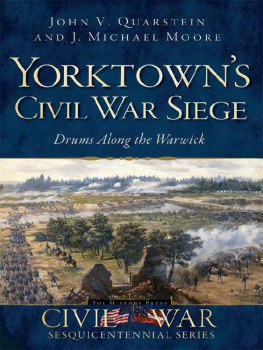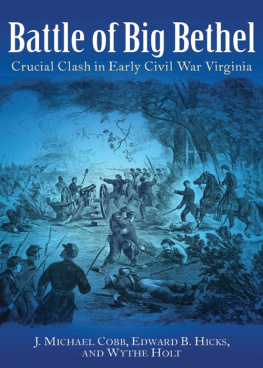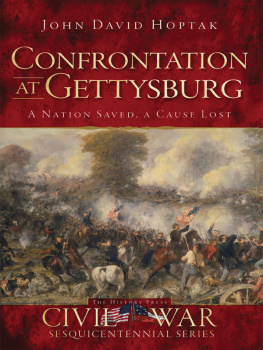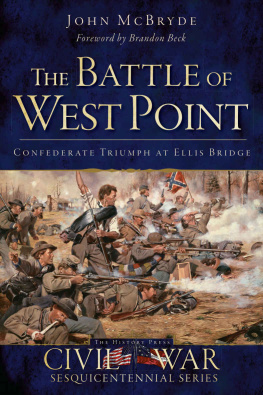B IG B ETHEL
B IG B ETHEL
The First Battle
J OHN V. Q UARSTEIN
Published by The History Press
Charleston, SC 29403
www.historypress.net
Copyright 2011 by John V. Quarstein
All rights reserved
Front cover: Winthrops Final Assault at Bethel Church, Gail Duke, 2011.
Back cover: top: Major General John Bankhead Magruder, CSA. Bottom: Brigadier General Abram Duryee, USA.
First published 2011
e-book edition 2011
ISBN 978.1.61423.068.7
Library of Congress Cataloging-in-Publication Data
Quarstein, John V.
Big Bethel : the first battle / John V. Quarstein.
p. cm.
Includes bibliographical references and index.
print edition: ISBN 978-1-60949-354-7
1. Big Bethel, Battle of, Va., 1861. I. Title.
E472.14.Q37 2011
973.731--dc22
2011013959
Notice: The information in this book is true and complete to the best of our knowledge. It is offered without guarantee on the part of the author or The History Press. The author and The History Press disclaim all liability in connection with the use of this book.
All rights reserved. No part of this book may be reproduced or transmitted in any form whatsoever without prior written permission from the publisher except in the case of brief quotations embodied in critical articles and reviews.
Contents
Acknowledgements
Big Bethel: The First Battle presents the series of events on the Virginia Peninsula that culminated in the 10 June 1861 Battle of Big Bethel. This is the story of how the Civil War evolved from passionate rhetoric to vicious combat. Even though the engagements luster would pale and be surpassed by much bloodier battles, it would be well remembered by those who fought at Big Bethel. It was, indeed, an awakening to the grim reality of war. Therefore, this volume is dedicated to the nineteen men who perished along the banks of Brick Kiln Creekmen like Henry Lawson Wyatt, John T. Greble and Theodore Winthrop, who left behind a record of bravery, all too often repeated throughout the next four years.
Big Bethel first interested me when I was growing up on Fort Monroe. It was marvelous to be there during the Civil War Centennial, especially when Dr. Chester Bradley, then curator of The Casemate Museum, befriended me. He told me stories about the battle as we looked at Lieutenant Grebles frock coat. This was amazing, allowing me to become part of this officers story. I knew then that I would one day write a book about Big Bethel.
Fast-forward thirty years. I had embarked upon some major Civil War preservation initiatives on the Peninsula. My success with these endeavors and my ability to articulate Hampton Roads dramatic Civil War heritage prompted my good friend and historic preservation patron Dorothy Rouse Bottom to request that I write a history of Big Bethel. I immediately agreed. However, after completing my research, my focus shifted to authoring books about ironclads and the Peninsula Campaign of 1862. Yet Big Bethel never left my mind. Nor could it, as my son, John Moran, would constantly ask me, So, how is Big Bethel? The Bethel story just kept building within me. Consequently, ten years later, when the Hampton Civil War Sesquicentennial Committee initiated an effort to preserve the last portion of the Big Bethel Battlefield, I realized the time had come to produce this volume.
The entire text was handwritten on a clipboard I used in the early 1960s and with my Parker Sonnet fountain pen. My text was transposed into a working document by Nancy Jones of the Pickett-Buchanan Chapter UDC and by my assistant, Heidi Walsh. J. Michael Moore, historian at Lee Hall Mansion, served as my primary reader. Michael also helped, ably supported by Dave Johnson of The Casemate Museum, to gather the lions share of the images needed to illustrate this book. Other photos, paintings, prints and sketches are from treasured collections held by the Virginia War Museum, The Casemate Museum, Hampton History Museum, Museum of the Confederacy, U.S. Military History Institute, John Moran Quarstein, Patrick Schroeder, Crickett Bauer Messman and Timothy Messman and the late Brian C. Pohanka. The front cover is a scene from an original painting by the ever-so-talented Gail Duke, who was commissioned to create a mural documenting the dramatic final moments of the battle. She did an outstanding job. Of course, the talented wordsmith and editor Julie Murphy of Circle C Communications must also be noted for her excellent and exacting work. As ever, she made sure that my words reached beyond the norm to tell the Bethel tale. Julie, a Tar Heel and member of the Bridgers Family Association, felt close ties to this story as she read of Captain John Bridgers and the Edgecombe Guards.
My appreciation must also be extended to Thomas B. Hunter of the Onondaga Historical Museum & Research Center for providing me detailed information about the Syracuse Zouaves. Of special note is Patrick Schroeder, who surveyed my text and was so gracious to enable me to reference Brian Pohankas manuscript, Red-legged Devils: History of the Fifth New York Volunteer Infantry: Duryees Zouaves. Patrick plans to publish this volume in 2012.
Big Bethel was written to support the ongoing effort to preserve and present the Big Bethel Battlefield. This preservation endeavor was aided by a wide variety of people. Many years ago, I took Sherry Greshamer of Bethel Chapter UDC to find the 1961 monument, long hidden in the woods of Langley Air Force Base. I never saw anyone so happy to find a monument, yet she was. She told me then, in 2006, that something must be done to make Big Bethel accessible. Accordingly, when I started establishing partnerships to establish a battlefield experience, the Bethel Chapter was the first group to offer support. Eventually, numerous groups like the Vermont Hemlocks, Raleigh CWRT, Hampton Civil War Sesquicentennial Committee, City of Hampton, Hampton History Museum Association, Virginia Civil War Trails, Langley Air Force Base, Pickett-Buchanan Chapter UDC, Hampton CVB, Chicago CWRT and Virginia Peninsula Chamber of Commerce Leadership Institute Alumni all joined together to help me create the battlefield park and interpretive trail, install the Vermont Monument, preserve the last section of the one-gun battery and relocate two older Bethel Chapter monuments into this park. So many individuals from these organizationsJim Wilson, Christine Gergely, Adanna Davis, Bruce Sturk, Sallie Grant-DiVenuti, Jim Tormey and Bob Allsbrookreally made a difference. Of course, I truly thank several others for making the extra effort to ensure success. My friend Dr. Bill Minsinger took the initiative for creating the Vermont Monument, and my former Leadership Institute student Loline Otzelberger helped gather and organize the volunteer team that was required. Charles Hawks of the Raleigh CWRT also must be given great accolades for helping to raise money.
Introduction
Virginias Hampton Roads region is home to so many historical firsts. Many of these great moments in time occurred during the Civil War. The Contraband of War decision and the duel between the ironclads USS Monitor and CSS Virginia (Merrimack) influenced the conflicts outcome and events that followed. One of the Civil War firsts that is often overlooked is the 10 June 1861 Battle of Big Bethel. While virtually a minor skirmish in comparison to the later vicious battles that epitomized the war, Big Bethel was the first time that Union and Confederate soldiers engaged in open combat. The clash also caused some of the wars first combat casualties, including the first Union soldier killed, the death of the first West Pointer and Regular Army officer and the mortal wounding of the first Confederate infantryman. Big Bethel was a precursor to the bloody battles to follow until the wars end in 1865.










